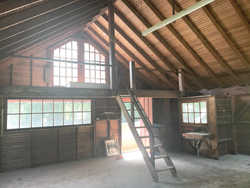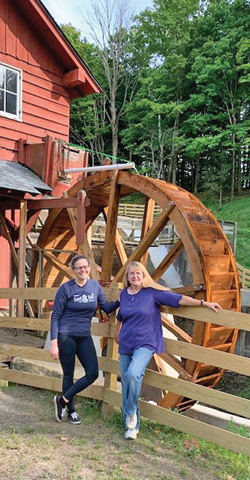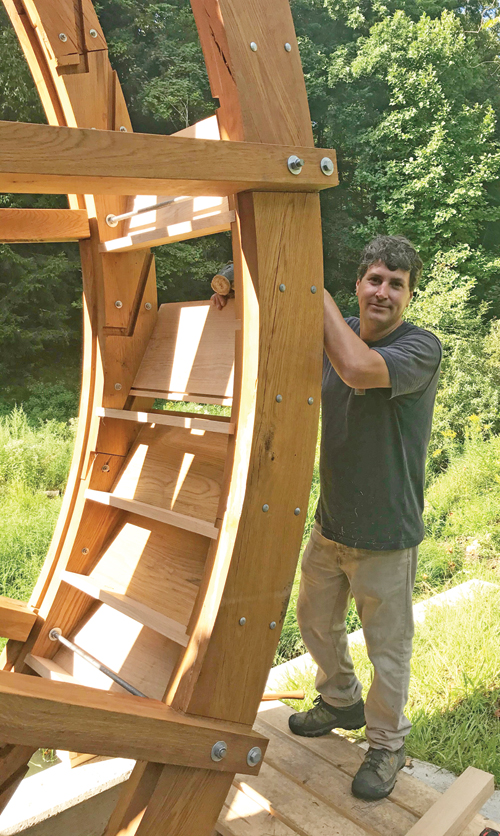After a half century, restored waterwheel back in action at Kirby Mill
by Dan Holland
One of the most visually striking sights for visitors to the south section of Richfield Heritage Preserve, with access from Oviatt Road, is Kirby Mill, nestled against the dam and spillway of scenic Lake Jinelle.
Millwright Ben Hassett, owner of B.E. Hassett-Millwrights, Inc., refurbished the components of the original waterwheel at his shop in Louisville, Kentucky over a one-month period. He then reassembled it piece by piece on site at the mill from Aug. 30 – Sept. 2.
Installation
Hassett explained that a telescoping forklift was used initially to lift the metal hub into place atop the concrete support piers. From there, he built the wheel one piece at a time from the hub. Fully assembled, the 16-foot diameter wheel, constructed of white oak, is estimated to weigh between 7,000 – 8,000 pounds, he said.

“I really like the design, and it’s going together a lot quicker than some of the other wheels I’ve worked on,” said Hassett who has been involved in millwrighting for 26 years. “Many of the 18th- and 19th-century wheels that I do reconstructions for have a wooden shaft – there is metal at the ends, but the bearings will be different and the arms go all the way through, and you have to mortice a wood shaft, which can take a long time to put together. So, this one is pretty enjoyable for how quickly it’s going together.”
Hassett stressed how the design of the wheel is such that all the components lock together into one cohesive unit.
“This thing spins great with the ball bearings, so it’s a really nicely-balanced wheel,” he said. “It kind of locks itself together. It’s assembled piece by piece, but at the end, it’s a whole interlocking unit, and when water gets on it, it swells and everything tightens up. There are fasteners in here, but we’re relying on joinery to help hold everything together.”
The 45 wooden “water buckets,” which fit into slots in the inner wheel frame, were the final items to be installed.

History
The restored waterwheel is a key component in the ongoing restoration of the mill as part of a fundraising effort initiated by Friends of Richfield Heritage Preserve, which began in 2015. To date, the group has raised more than $200,000 for the project, with a final goal of $500,000. Restoration of the waterwheel cost $84,000, according to the group’s president, Corey Ringle.
Inventor James Kirby constructed the mill in 1922 using gristmill technology to supply electric power to his mill workshop, with the Kirby family home residing just a stone’s throw away along Lake Jinelle. The waterwheel was designed to work with a low-flow stream, with the metal wheel hub being balanced on ball bearings to provide a highly efficient transfer of energy.
Other completed components of the mill restoration include a new roof, restored windows and concrete repair of the waterwheel supports and pit. A number of additional improvements are still slated for the structure, which is listed on the National Register of Historic Landmarks.
“Even before it was a park, we knew how important that hydroelectric wheel and the story of Jim Kirby was,” said Ringle. “It kind of inspired the Girl Scouts in STEM education so the minute it became a park, it was at our forefront to save what we thought was the most iconic and recognizable structure in the park.”
The 336-acre municipal park, previously owned by the Cleveland Girl Scout Council, operated as Camp Crowell Hilaka until December 2011. In November 2014, residents of Richfield Village and Richfield Township approved a bond issue to purchase the property along with a levy to fund continuing operations.
With restoration of the waterwheel complete, plans call for the eventual installation of an apparatus to once again generate hydroelectric power at the site.
“One of the next major items we want to get are the guts to make it function,” said Ringle. “We’ve talked to some people with the Society for the Preservation of Old Mills, and they gave us some recommendations for the electronics. We also would like to establish a mill endowment fund so that it never becomes a burden of the taxpayers to maintain it.”
Community asset
Hassett stressed the historical and aesthetic value that the mill brings to the area.
“This is a great resource for the community,” he said. “And it has one of the most fun-looking dams and spillways I’ve ever seen. It looks like a theme park almost – like an adventure ride. The mill in itself is a destination, but as part of the whole complex, with the rest of the Kirby structures that are here, it all tells a really unique and interesting story.”
“If the community walks away with one item from the mill wheel, it is that it’s very iconic; it draws whimsy and intrigue to learn about the community, and it wouldn’t have been possible without our many generous donors,” added Ringle.
“Richfield really values its history, and I think this just speaks of the dedication of the community,” she continued. “This mill wheel could have been anywhere, and who knows if it would have survived if not for the residents. It survived due to the residents’ commitment to history and education – all of the things that make the mill so awesome.”
Friends of RHP will host its “One in a MILL-ion” centennial celebration and fundraiser event at the Lodge at RHP on Sunday, Oct. 16. ∞
featured photo: Ben Hassett is adding “buckets” to the water wheel that he and his crew built in their Louisville, Kentucky shop. Photo by D. Holland.

